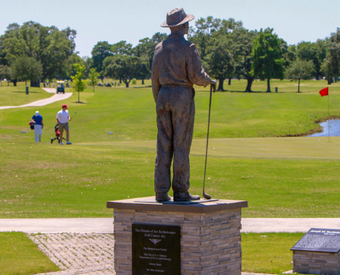Joseph Bartholomew: The architect who couldn't play through
08 Feb 2022
by Sean Melia of AmateurGolf.com
SHARE:
In celebration of Black History Month, we're happy to share some of the stories of African-Americans who have played a significant role in the growth of golf, both on and off the course. AmateurGolf.com's course design and architect enthusiast Sean Melia tells the story of Joseph Bartholomew, who rose from the caddy yards in the Deep South to a respected golf course designer.
* * * * *
Born in 1888, just 23 years after the end of the Civil War, Joseph Bartholomew had the decks stacked against him as an African-American in racially-segregated Louisiana, New Orleans to be exact. His story in the Jim Crow south is one of perseverance, resilience and how golf helped pave his way in life.
Bartholomew's introduction to golf began at the whites-only Audubon Park Golf Course, where he began caddying as a young child. Each day Bartholomew not only collected his $3 salary, but he also watched the players in his group closely, soaking up as much as he could about the sport.
His attention and hard work paid off. Freddie McLeod, the club pro, noticed the promise that Bartholomew possessed. McLeod wasn’t just any club pro, he would go on to win the U.S. Open in 1908 at Myopia Hunt Club in Massachusetts. McLeod taught Bartholomew to build and repair golf clubs and eventually offered him a job, and a hefty pay cut. McLeod could only pay Bartholomew 50 cents a day.
Bartholomew understood the value in McLeod’s teachings and decided to take the lower-wage job with the understanding that he would learn more under McLeod’s tutelage than out on the course helping players find their golf balls.
Bartholomew continued to move up the golfing ladder, taking the job of the superintendent at Audubon; he also started giving lessons. The decision to take the pay cut paid off, as each lesson earned him $2 and he would give as many as 12 lessons a day.
“I figured I can learn more from Mr. McLeod than I can as a caddie. So, I took it,” Bartholomew said in an interview.
What transpired next is what truly put Bartholomew on the golfing map. He tried his hand at golf course design and proved to be more than adept. Maybe it was all those rounds at the famed Audubon Golf Course paired with his endless curiosity, but whatever it was, he earned the respect of the New Orleans golfing elite. In the 1920s they sent him to New York City to learn more about his new passion. This wasn’t just any education, Bartholomew studied alongside, Seth Raynor, who would go on to design world-class layouts such as The Course at Yale, Waialae Country Club, Fishers Island Club, Fox Chapel Golf Club and Yeamans Hall Club, to name a few.
“Whooo, but I was surprised,” Bartholomew told Fortune magazine in 1949. “They gave me a whole bunch of money and told me to go and find the best course in the world and bring it back.”
 Joseph Bartholomew Golf Course in New Orleans
Joseph Bartholomew Golf Course in New Orleans Bartholomew returned with a wealth of knowledge, ready to apply his lessons to the Louisiana soil. In designing and building the Metairie Golf Club, he found the land that Metairie had designated for the course was hidden back in the woods, so Bartholomew did a lot of his work at night. When the membership questioned Bartholomew’s progress, he brought them out to the course site in a wagon and showed them his work. They were so impressed they gave him a raise and never questioned him again.
Unbelievably, due to segregation laws, Bartholomew was never allowed to play Metairie. It wasn’t the only course Bartholomew designed that he wasn’t allowed to play. His City Park Nos. 1 and 2, along with Pontchartrain in New Orleans, were also segregated.
Bartholomew made most of his money in real estate. He foresaw the westward suburban sprawl from New Orleans and bought up land. He would drain the wetlands and sell the land for development. However, he took one piece of land in Harahan, La. and built a seven-hole golf course. It is not in existence anymore and has been lost to housing development in the town.
Eight years after his death in 1971, the first municipal course in New Orleans, Pontchartrain Golf Course, was renamed Joseph Bartholomew Golf Course in honor of its course designer. Bartholomew was also the first African-American to be elected into the Greater New Orleans Sports Hall of Fame in 1972.